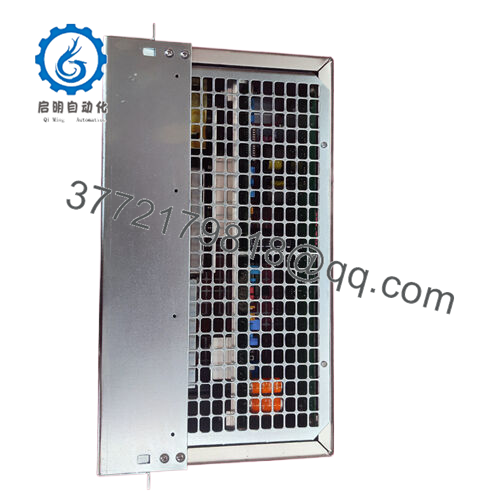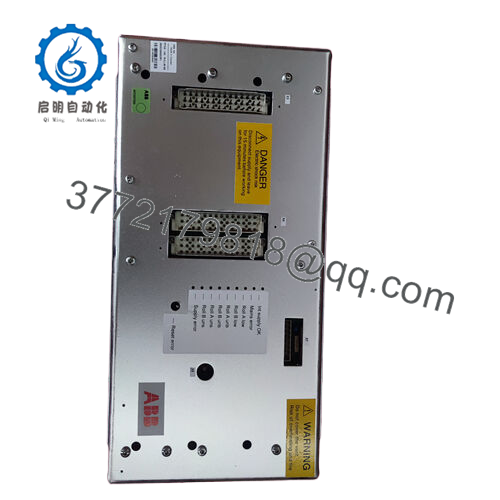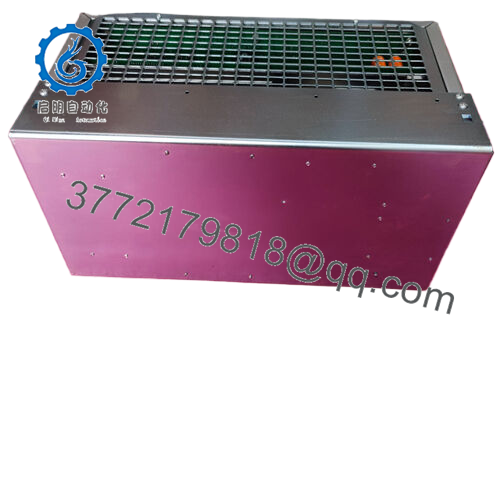Description
In the precision-driven world of industrial automation, where roll force and flatness measurements dictate the quality of rolled products, the inconsistency of supply voltages or unstable power feeds can distort sensor signals, leading to skewed profile data, uneven strip edges, or outright mill stalls—scenarios that not only compromise material yield but also escalate energy waste and safety risks in high-throughput lines like steel or aluminum processing. Envision a hot strip mill where fluctuating excitation to force transducers yields phantom camber readings, triggering overcorrections that buckle coils, or a foil rolling setup where ripple-laden rails jitter load cells, amplifying defects that cascade into downstream scrap and rework cycles. These vulnerabilities peak in demanding environments, where thermal cycles, dust, and vibration challenge power integrity, underscoring the need for a dedicated supply unit that delivers rock-steady regulation to underpin accurate process control without the downtime of intermittent faults.
Engineers optimizing flatness systems in DCS-integrated mills often grapple with modules that introduce noise or fail under transient loads, fragmenting measurement chains and eroding high reliability amid the electromagnetic soup of nearby inverters. The ABB PFSA140 3BSE006503R1 emerges as critical here, functioning as a roll supply unit tailored for ABB’s flatness measurement ecosystem, where it conditions 24 VDC inputs to provide clean, isolated power for transducers and amplifiers in applications like shape control or tension profiling. It’s a cornerstone in sectors such as metals fabrication or paper converting, where I/O signal purity directly safeguards compliance with ASTM flatness tolerances, averting the ripple of production halts from supply-induced drift that could idle lines for hours. Absent this level of conditioning, you’d resort to bulk regulators or frequent grounding tweaks, rerouting expertise from profile tuning to voltage hunts in the crush of shift handovers.
As rolling mills evolve toward predictive analytics in industrial automation, the demand sharpens for supply units that incorporate diagnostics without inflating cabinet heat loads. The ABB PFSA140 3BSE006503R1 distinguishes itself with its hot-plug design and low-ripple output, fortifying against common-mode interference up to 100 V while enabling seamless swaps in live operations—repositioning raw power into a fortified feed for Pressductor sensors. This unit isn’t generic rectification; it’s the pulse stabilizer that channels stable excitation to force chains, empowering your team to extract variance trends for proactive roll gap adjustments rather than sifting noise in waveform captures. In audit-heavy domains like automotive sheet production or aerospace alloys, where measurement fidelity ties to defect rates under 0.5%, it bolsters signal reliability that extends to IIoT overlays, forging a resilient backbone for data-rich, adaptive process control.

PFSA140 3BSE006503R1

PFSA140 3BSE006503R1
| Specification | Details |
|---|---|
| Model Number | 3BSE006503R1 |
| Brand | ABB |
| Type | Roll Supply Unit |
| Input Voltage | 24 V DC |
| Operating Temp Range | -20°C to +50°C |
| Mounting Style | DIN Rail (S800 Cabinet) |
| Dimensions | 90 x 100 x 35 mm |
| Weight | 0.7 kg |
| Interface/Bus | Terminal Blocks |
| Compliance | CE, RoHS, UL |
| Supported Protocols | N/A (Power Conditioning) |
| Typical Power Draw | 5 W |
The ABB PFSA140 3BSE006503R1 integrates at the conditioning layer of your flatness stack, taking facility 24 VDC and filtering it through active regulation to output low-noise rails for roll force transducers, slotting into S800 backplanes or standalone enclosures where it pairs with amplifiers like the PFEA series to drive magnetoelastic sensors without introducing offsets—conceive it as the quiet rectifier in a measurement mesh, honing excitation currents to 0-10 V or 4-20 mA spans for precise load profiling. This positioning keeps it central to the I/O architecture, proximal to termination units for short runs that curb EMI pickup, while its terminal blocks facilitate shielded wiring to field mounts amid mill clamor.
What defines its operational fit is the intuitive resilience: built-in fusing and LED diagnostics flag undervoltages or thermal trips, streaming status via binary outputs to DCS gateways for HMI alerts, so a dip doesn’t cascade to false flatness deviations. In multi-roll configs, it powers parallel chains with balanced loads up to 5A total, supporting redundancy by daisy-chaining to duplex units for bumpless handoffs during roll changes. Upstream, it draws from redundant PSUs; downstream, it energizes sensor coils in the Pressductor loop, all tunable for ripple rejection below 50 mVp-p to match IEC 61000 immunity. For legacy ties, the ABB PFSA140 3BSE006503R1 bridges older Bailey systems via analog interfaces, hot-pluggable to expand measurement density without process pauses, evolving your flatness feeds toward fault-tolerant, edge-conditioned process control that anticipates distortions over echoing them.
Opting for the ABB PFSA140 3BSE006503R1 arms your rolling lines with excitation endurance that neutralizes the noise of power flux, particularly in force loops where ripple could otherwise fuzz camber profiles and spawn edge waves. During sustained runs, this manifests as measurement steadiness that persists—transducer outputs hold linear without wander, enabling tighter crown controls in tandem mills and forestalling the yield hits from overbends that lesser supplies provoke, yielding crisper strips and slimmer defect logs for your quality leads.
This unit’s regulatory rigor further eases the fray, with thermal derating that sustains output through ambient swings, obviating the cooling add-ons that clutter legacy panels in hot zones and enshrining performance consistency amid throughput throbs. Technicians harness its status relays to forewarn anomalies, routinely isolating connector corrosion before it biases baselines, which condenses diagnostics and stretches service spans in the process. Crafted for the unceasing rhythm of strip duty, it dovetails with efficiency edicts, its modest draw lightening UPS loads in green mills. And its DIN affinity curtails retrofit rigmarole, snapping to standard rails sans spacers, so your upgrades unfold unforced.
Moreover, the ABB PFSA140 3BSE006503R1 nurtures nodal growth: optional fault buses graft to Ethernet for predictive health models, stewarding value as 800xA fabrics layer ML shape algos. This pliancy trims validation toils, with log-stamped rails ratifying ISO 9001 sans adjuncts. At its core, it’s a fulcrum for filtered fidelity, where adroit amplification allays artifacts from coil to caliper, recasting supply stutters into shaped successes.
In cold rolling complexes, the ABB PFSA140 3BSE006503R1 conditions power for backup roll sensors in temper mills, channeling stable feeds amid coolant sprays and speed bursts, where its ripple guard and hot-plug grace secure critical system uptime in process control environments lashed by hydraulic hum—high reliability holds in mapping strip flatness without gauge bands.
Aluminum foil lines enlist the ABB PFSA140 3BSE006503R1 to energize cluster transducers under vacuum pulls, braving particulate veils with IP20 tenacity for fast data cycles that sustain thickness holds—key for continuous uptime in process control where excitation purity curbs pinholes.
Non-ferrous strip casters deploy the ABB PFSA140 3BSE006503R1 for caster roll profiling in ingot runs, enduring thermal gradients with 24 V fortitude to underpin high reliability in process control environments demanding unerring force amid molten flows.
PFSA141 3BSE006504R1 – Enhanced variant with dual outputs for parallel transducer arrays in multi-stand mills.
PFSA130 3BSE006502R1 – Compact predecessor for lighter load conditioning in legacy flatness setups.
PFTL101B 2.0KN 3BSE004185R1 – Compatible load cell for horizontal force integration with supply feeds.
PFEA111 3BSE042238R2 – Tension electronics module for paired signal amplification in web lines.
PFSA150 3BSE006505R1 – Higher-current edition for heavy-gauge rolling with overload buffers.
3BSE018741R15 – Cable connector add-on for extended field wiring in dusty enclosures.
PFCL351 3BSE042810R1 – Fieldbus gateway for tying supplies to PROFIBUS networks.
Prior to racking the ABB PFSA140 3BSE006503R1, align input polarity with your PSU diagram—reversals hash rectification; ABB’s config tools simulate this offline. Sum downstream loads to confirm 5A ceiling, and berth with 50 mm vents for the 50°C limit, as ambient dust can throttle airflow—mesh filters if enclosures clog. Torque terminals to 0.6 Nm for vibration grip, and bench-test with a dummy sensor to verify ripple, unmasking filter faults pre-energize.
Once embedded, maintenance leans on measured monitors. Weekly, scan LEDs for low-voltage cues—dips under 23 V signal fuse pops, fixable with spares in humid hides to bar bridging. Quarterly, cycle outputs under full draw to check regulation, noting drifts from cap age; in oily orbits, isopropyl wipes on blocks thwart residue. Gather relay logs semiannually to map MTBF paths, oft from thermal ticks, and sync with EMC proofs by injecting noise. These paces, parsed to patrols, preserve the unit’s poise without plotting pauses, unspooling smarts that shepherd spares shrewdly.


 WhatsApp: +86 16626708626
WhatsApp: +86 16626708626 Email:
Email:  Phone: +86 16626708626
Phone: +86 16626708626


